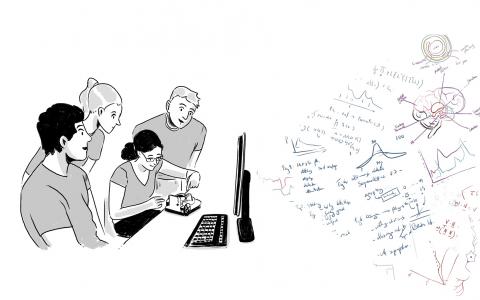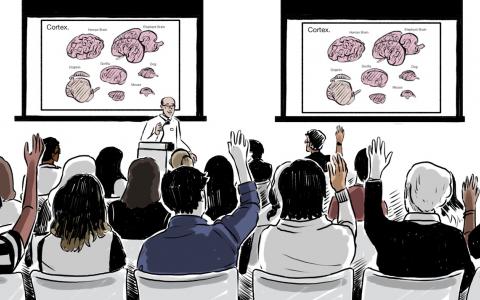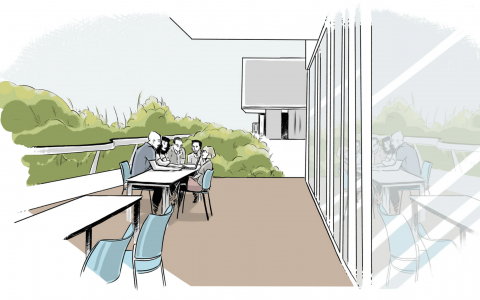
8 ways to improve translation between industry and academia in neuroscience
By April Cashin-Garbutt
From speaking the same language, aligning incentives and improving transitions between academia and industry, SWC Seminar speakers share their thoughts on how to improve translation in neuroscience.
1. By talking more!
“For starters, people need to talk to each other! For a long time, I had biases about industry, but I was wrong about many things. I visited many large companies and I found it very interesting to talk to people, not just in research and development, but also the CEOs and personnel managers who sometimes think deeply about the problems of collective behaviour and collective intelligence and they often have a very different perspective from their own daily experience.
These conversations with industry have been very good for me and my team in guiding some of our academic research and giving it a different framework. It has been difficult doing this over video calls during the pandemic but I hope that we will be able to visit again in person soon, as you learn a lot from immersing yourself in the environment of others and seeing the environment in which people make decisions.” Professor Jens Krause, Humboldt University, Berlin
“People need to talk more! Clinical conditions can help us understand the brain. For example, there are a lot of disease models that have olfactory deficits, however many people are not good at describing their sense of smell. In animals, we can use genetic lines to perturb the olfactory system and see what happens to their physiology and behaviour.” Dr Cindy Poo, Postdoctoral Researcher, Champalimaud Research
2. By aligning incentives
“Perhaps one of the things we could and should ask ourselves is how to align incentives? We, as scientists, work on projects oftentimes with the goal of understanding something. In industry, the moto is slightly different: something has to serve a purpose and the solution doesn’t need to be perfect, good enough is OK. So we need to align our incentives and understand they are in a sense different; yet they are complementary. Industry can take an insight and develop it, perfect it into a product. Something that is easier said than done! Production mode comes with all sort of new challenges. We have seen it for instance in the case of the Covid 19 vaccine, development is one thing, production is another.” Dr Lucia Melloni, Group Leader at the Max Planck Institute for Empirical Aesthetics in Frankfurt am Main, Germany
3. By speaking the same language
“It’s hard because industry and academia have very different languages. Industry is profit-driven, so they want something that’s fast and is going to make them money. In contrast, intellectual curiosity in science is neither fast nor profit-driven. I would love to be part of the conversation that helps bring these disparate ways of thinking more into alignment. There’s lots of potential there.” Dr Michele A Basso, Professor in the Departments of Psychiatry and Biobehavioral Sciences and Neurobiology, UCLA
4. By partnering on training to improve transitions between academia and industry
“I hope that in the future the transition between academia and industry will also be smoother. We should change the way we train our people: perhaps having partnerships with industry so that students actually spend some time there and so forth. From idea conception to product materialisation, there is a huge development, so we should also think about at what level we want to start interacting.” Dr Lucia Melloni, Group Leader at the Max Planck Institute for Empirical Aesthetics in Frankfurt am Main, Germany,
“We need to have more points of contact between neuroscience and medicine, both in neurology and psychiatry. This could be through integrated training programmes and so forth. I think many neuroscientists are really interested in getting exposure to clinical day-to-day work and many clinicians would value opportunities for more in-depth training in neuroscience, but the reality is this exchange between these fields is not happening very much.” Dr Katharina Schmack, Group Leader at Francis Crick Institute and University College London
“Industry and academia have very different cultures and I have seen first-hand how the interface between science and medicine changes as you move from country to country. But everywhere I have been, I have observed a need for more interaction and more overlap in terms of training. I think this is key to creating an environment that encourages more translation from fundamental research into the clinic or industry.” Dr Joe Paton, Champalimaud Centre for the Unknown
5. By focusing on how close projects are to application in humans
“I’ve noticed a very dramatic change in the past 5-10 years. When I was a graduate student, we rarely talked about translation because it seemed so far in the future, but more recently this has been a bigger focus due to advances in genetic tools. We can now modify genes and, because we know changes to genes are responsible for certain diseases, we can try to treat people.
The Institute of Neuroscience is establishing a big translational centre in Shanghai and when we design projects now we always think about how close they are to application in humans and whether they will help certain diseases and improve quality of life. For example, for people that have problems sleeping, can we develop a small device that promotes sleep?” Dr Yu Mu, Institute of Neuroscience, Chinese Academy of Sciences
6. By integrating human and animal research
“From my clinical point of view, one important aspect is to integrate human and animal research. It’s very useful to go back and forth between animals and humans to make sure that we are still targeting what we are intending to target.” Dr Katharina Schmack, Group Leader at Francis Crick Institute and University College London
7. By making use of viral vectors
“One of the recent trends in neuroscience is to use viral methods and these have also been used in a translational setting. Viral vectors can be used to repair gene deficits in patients with diseases. In the future, I think we will be able to use these viral methods firstly to understand what goes wrong at the circuit level in the brain and then use viral vectors as a vehicle to target certain cell types and fix very specific parts of the brain.” Dr Sarah Ruediger, University of California, San Francisco
8. By bridging the gap between neuroscience and AI
“I think we also need to bridge the gap between neuroscience and artificial intelligence. Neuroscience really inspired the AI field back in the day – they were called neural networks because they were based on the cortex, but the fields have really diverged. I think both fields, and also humanity, would benefit from bringing them closer together.
For example, imagine if we had robots that could do some of the tasks involved in helping elderly people: organising their home, washing the dishes, loading the dishwasher, unpacking groceries. This would allow people to live independently for much longer than they do now. So I think we need to have more links between AI and neuroscience so that we can build better robots and better algorithms to do things that could make people’s lives better.” Dr Anne Churchland, Professor in Neurobiology at UCLA


